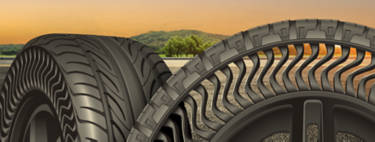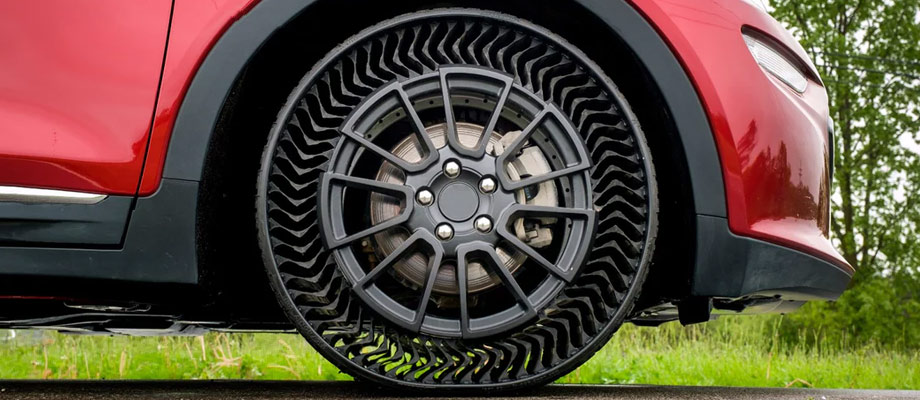Airless tires: what you should know
By: Discount Tire

A “pneu” idea: airless tires!
We’re no strangers to flat tires and blowouts.
Eventually every vehicle owner will know the frustration of your TPMS warning lights going off—or even worse—having your tire blowout as you are on a busy highway.
But what’s the most common cause of tire problems?
Two words: air pressure. Your tire’s performance and longevity relies heavily on making sure your tires are inflated properly. The concept of tires being filled with air or nitrogen has become a way of life for drivers for over a century.
Wouldn’t it be nice if you didn’t have to worry about it?
Enter airless tires. Michelin first created a concept of an airless tire back in 2005, with the intention of promoting safety and convenience by reducing flat tires and blowouts. Michelin debuted their “tweel” design (a play on its design, which combines a tire and wheel into one solid piece) to high acclaim. TIME Magazine called it “One of the Most Amazing Inventions of 2005”, but it has since largely stayed in its research and development phase with a tentative release for 2024.

So... how can a tire be “airless”?
The tires we all currently drive on are called pneumatic tires. These consist of an airtight inner core and a tread reinforced with a steel belt. These rely heavily on proper inflation because the right pressure provides resistance and a cushioning effect when the tire encounters road bumps and obstacles. While these are reliable when maintained properly, they are more prone to punctures and are completely useless after they’re damaged.
The “tweel” airless tire resembles the modern bicycle wheel. The multiple spokes arranged in a wedge pattern help absorb road impact similar to how air pressure does for pneumatic tires. Although these tires ride stiffer, the design is such that the spokes bend and spring back into shape when in use.
Since its debut, Michelin has partnered with General Motors to develop and test a tweel model known as “Uptis” (Unique Puncture-Proof Tire System), with the goal to bring airless tires to passenger vehicles by 2024.
What are the pros and cons of airless tires?
Airless tires certainly pose some benefits for vehicles and tire manufacturers:
- No flat tires and blowouts:
Since these tires aren’t filled with air, there’s no chance they can go flat. The spokes and the material for any airless tire will be strong enough to withstand the hazards or forces that degrade or otherwise destroy normal tires. This also potentially eliminates the need for a spare tire, which lightens up trunk space and provides better fuel economy.
- Eco-conscious production:
The structure and engineering of airless tires allows for the use of sustainable materials and less CO2 emissions during production. We don’t know if these will have to be replaced as often as normal tires yet, but airless tires are designed to be low maintenance so we can expect them to last a long time (and reduce our carbon footprint in the process). The automotive industry is moving toward a more sustainable future with electric and hybrid cars, so why not also do the same with our tires?
However, they can also pose some disadvantages:
- Less comfort:
These tires have more rolling resistance than pneumatic tires and the stiffness may be a reduction in smoothness, noise and overall comfort.
- Less adjustability:
With conventional tires, the air pressure can be modified per the road conditions you’re driving on. Airless tires lack versatility and most likely won’t be adaptable to various road conditions.
- Less personalization:
Because airless tires integrate the sticky portion of the rubber contact patch into their spoke cushioning system, the spokes themselves remove the need for an actual wheel. Most people don’t tend to focus on wheels for their vehicle, but if airless tires catch on, wheel designs will be in demand for enthusiasts and vehicle owners alike. This likely could conjure up some innovative wheel designs in the future.
When will we see airless tires on the market?
Airless tires won’t be rolling out anytime soon, but the general consensus indicates that we could see them in the market by 2024. They’ll need to be cost-effective in terms of resources and production for tire manufacturers, but the process of making airless tires is radically different than what the process of making tires has developed into over the last 100 years.
At the end of the day, if your vehicle rides on it, Discount Tire can set it up. We’ll be sure to update this page as we learn more about airless tires, but it’s an interesting time for the auto industry that we’re eager to help our customers learn more about!
For more information on this and other tire and wheel services, check out our YouTube Channel or reach out to us on Twitter, Facebook and Instagram.